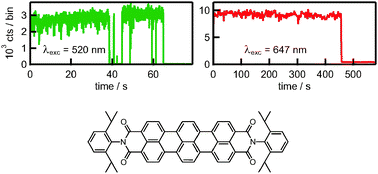We investigate photoblinking and photobleaching of perylene diimide (PDI) and its higher homologue terrylene diimide (TDI). Single molecule fluorescence trajectories of the dye molecules embedded in PMMA under ambient conditions exhibit “on”–“off” blinking in the time range from ms to s. Due to the limited statistics of individual trajectories we construct ensemble distributions of “on” and “off” times which follow power laws with similar power law coefficients (mon ≈ 1.18, moff ≈ 1.31). The blinking is attributed to reversible formation of radical cations which are presumably created by electron transfer from higher excited triplet states Tn of the molecules to acceptor levels in the PMMA host. This view is corroborated by the properties of TDI, which blinks at an excitation wavelength of 520 nm but does not at lower energy excitation (647 nm). In line with this observation, T1–Tn absorption data of TDI (and PDI) indicate that above a certain illumination wavelength population of higher excited triplet states Tn does not occur, preventing blinking. It is furthermore argued that the long-lived dark (“off”) states, i.e. the radical cations, are precursors for the photobleaching process of the dye molecules. Consequently, the photobleaching quantum yield Ybl for TDI is very small at an excitation wavelength of 647 nm (Ybl = 2 × 10−10) but increases by two orders of magnitude at 520 nm (Ybl = 2 × 10−8), which lies in the range observed for PDI investigated with an excitation wavelength of 488 nm. Additional studies of a PDI–TDI donor–acceptor dyad give further insights into the blinking and bleaching processes. Important findings include the observation of power law blinking of TDI and PDI (after bleaching of TDI) with similar coefficients as found for the isolated chromophores. Furthermore, in the dyad the photostability of TDI decreases due to efficient population of the states Tn by singlet–triplet annihilation, while that of PDI (after bleaching of TDI) is the same as for the isolated dye. These findings support the conclusions drawn for the isolated chromophores, in particular the involvement of the triplet manifold in the blinking (and bleaching) behavior.

You have access to this article
 Please wait while we load your content...
Something went wrong. Try again?
Please wait while we load your content...
Something went wrong. Try again?


 Please wait while we load your content...
Please wait while we load your content...